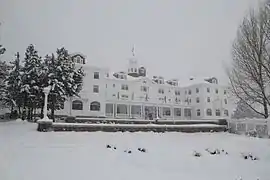Freelan Oscar Stanley
Freelan Oscar Stanley (June 1, 1849 – October 2, 1940) was an American inventor, entrepreneur, hotelier and architect. He made his fortune in the manufacture of photographic plates but he is best remembered as the co-founder, along with his twin brother Francis Edgar Stanley, of the Stanley Motor Carriage Company which built steam-powered automobiles until 1920. He also built and operated the Stanley Hotel in Estes Park, Colorado.[1]
Freelan Oscar Stanley | |
|---|---|
 | |
| Born | Freelan Oscar Stanley June 1, 1849 |
| Died | October 2, 1940 (aged 91) |
| Resting place | Riverside Cemetery Kingfield, Maine |
| Education | |
| Known for | Stanley Steamer, The Stanley Hotel, Rocky Mountain National Park |
| Board member of |
|
| Spouse(s) | Flora Jane Record Tileston |
| Relatives |
|
Early life
Freelan Oscar Stanley and his identical twin brother Francis Edgar (1849-1918) were born on June 1, 1849, in Kingfield, Maine.[1] They were the third and second, respectively, of the seven children of Solomon P. Stanley II (1813–89) and Apphia Kezar Stanley (nee, French. 1819-74). Although their family was not wealthy, education was highly valued and knowledge of science, poetry and music were encouraged from a young age. Their younger sister Chansonetta Stanley Emmons went on to achieve significant recognition in her own right as a photographer. Their elder brother Isaac Newton Stanley was named for the eminent English scientist while their younger brothers received the names of Solomon Liberty Stanley (after the family patriarchs) and Bayard Taylor Stanley (in memory of the celebrated American literary figure) Their younger brothers who died in infancy were named John Calvin Stanley (in memory of the protestant reformer) and Ulysses Grant Stanley (in memory of the Union commander and US President). It has been suggested that the names Francis Edgar and Freelan Oscar were drawn from the pages of Sir Walter Scott although Edgar appears to be the only one of their names shared with a character from his works. Scott's Marmion had special significance to the Stanley brothers, uniting their love of poetry and the arts with pride in their Scottish ancestry. "On, Stanley, on!" a battle cry quoted in this poem became the motto of the Stanley Dry Plate Company featured on their packaging (albeit with an error in punctuation) above a logo of a knight on horseback.
In 1859, At the age of nine, Freelan and Francis started their first business together refining and selling maple sugar. The object of their hard-earned money was woolen cloth for new school suits and a copy of Benjamin Greenleaf's National Arithmetic in which book they worked every equation from cover to cover. At eleven, their great-uncle, Liberty Stanley, who had raised their father as his own son, taught them the art of violin making. By the age of sixteen, Freelan had completed three instruments. He would continue to make them throughout his life creating many concert-quality pieces still prized today by collectors and musicians. In 1863, in the midst of the American Civil War, the brothers were witness to the Kingfield Rebellion, a protest against the highly unpopular Enrollment Act and the only anti-Union rebellion to occur in the State of Maine.
In 1870, at the age of twenty the brothers began their collegiate education at Western State Normal School (now University of Maine, Farmington) with the intention of becoming educators.[2] Francis Edgar soon found that academic schooling was not to his liking and left to pursue a career as a portrait artist. Freelan continued his education at Hebron Academy from 1871 to 1873 and finally Bowdoin College in Brunswick from 1873 to 1874 where he was in the same class as Arctic explorer Admiral Robert Peary. he was present during the so-called Drill Rebellion, in which Bowdoin pupils refused to participate in the daily military drills mandated by college president, Joshua Chamberlain.
Following his time at Bowdoin, Stanley accepted a position as headmaster of the high school in Mechanic Falls, Maine[3] where he met Flora Jane Record Tileston (1847-1939). She was a teacher and a pianist of some competency. They were married in 1876. In 1881, Stanley was struck with Tuberculosis. His younger brother Solomon Liberty was carried off by the disease the same year at the age of 27. Freelan believed his survival depended upon a less sedentary life and so he decided upon a career in manufacturing, opening the Stanley Practical Drawing Set factory. Unfortunately, his new business was ruined in a fire which destroyed the whole of his investment only a year later, in 1882.
Stanley Dry Plate Company
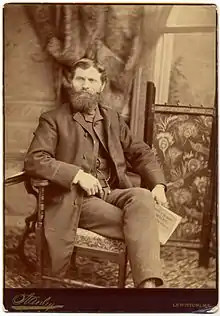
After leaving school, Francis Edgar Stanley married Augusta May Walker (1848-1927) and opened a portrait studio. His first technique was "crayon" or charcoal which he supplemented with his "Improvement to the Atomizer," a forerunner of the modern air brush which he patented in 1876. In 1882, Francis began experimenting with photography about which he quickly became passionate. Following the tragic conflagration of his brother's factory, Francis suggested that the two work together to create a new photographic product. By 1885, the Stanley brothers had established the Stanley Dry Plate Company in Lewiston, Maine. The first primitive dry photo plate was invented by the English physician Richard Leach Maddox in 1871. Charles Bennett discovered important improvements upon the original formula but, ten years later, most photographers were still using the wet plate collodion process. By perfecting their factory process and marketing their product across the country, the Stanley Company quickly rose to predominance at a time when the market for factory-made (rather than studio-made) photo materials was just opening. The brothers quickly amassed a small fortune and, in 1890, they moved their business to Watertown, Massachusetts and bought homes in nearby Newton.
In Newton, Freelan and Flora Stanley emerged as members of well-to-do society. In 1894, Freelan built a Colonial Revival house at 165 Hunnewell Avenue in the Hunnewell Hill neighborhood of Newton Corner. In 1896, His brother built a home for his own family close-by at 638 Centre Street, acquiring, soon thereafter, a summer residence at Squirrel Island, Maine. In 1897-98 the twins purchased land and began construction on the Hunnewell Club, the seat of a social organization for their neighbors and friends. The building housed a ballroom, billiard tables and bowling alleys.
In 1900-1904, F.O. Stanley drew plans for the Amos G. Winter House in Kingfield, Maine. L.A. Norton executed the construction of the house which still stands at 33 Winter's Hill Road and bears a notable similarity to Stanley's other architectural designs.
Stanley Motor Carriage Company


Freelan and Francis Stanley were now living in the heartland of Yankee ingenuity and the inquisitive brothers were well-poised to immerse themselves in the many exciting technological advancements happening around them. Adjacent to the Stanley dry-plate factory in Watertown was a bicycle factory owned by Sterling Elliott. F.E. Stanley quickly became fascinated by the new bicycle craze and attempted to interest his wife, Augusta. When she fell off and swore she would never ride again, Francis told her, "Never you mind, Gustie. I will build something so that we can ride together in safety and comfort." Francis Stanley began the construction of an automobile and the project quickly absorbed his attentions. After contemplating the merits of combustion, electricity and steam, he determined that steam was the most practical option. His brother and he would hold steadfastly to the superiority of steam-power well after combustion had achieved predominance. By 1897, he had sold his horses and buggies and built his first automobile of wagon and bicycle parts from Sterling Elliott's factory. Not long after completing it, the Stanley Brothers took Francis' car to the Boston Auto Show (1898) held in Charles River Park, and so impressed the crowd that afterwards they began to produce steam cars on order as the Stanley Motor Carriage Company. From that moment on, Freelan Stanley was also committed to his brother's passion for motor cars.
In 1899, John Brisben Walker (editor of Cosmo, and early investor in the area around Colorado Springs) expressed interest in purchasing the Stanley's car business. The brothers were reluctant and decided to ask for a good deal more than they thought he would accept - $250,000 in ready cash. To their surprise, Walker accepted their offer immediately although he had to seek the partnership of "Asphalt King" Amzi L. Barber to finance the deal. For a few months, Walker and Barber managed the enterprise together. During this period, although they no longer owned the company, the Stanley Brothers stayed on as consultants; Francis in manufacturing and Freelan in marketing. This period was distinguished by a number of publicity stunts for which Stanley automobiles received much notoriety.
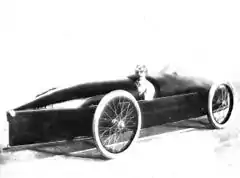
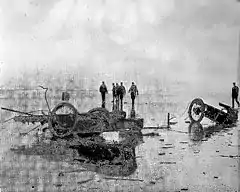
In August 1899, Freelan and Flora Stanley became the first of many motorists to reach the top of Mt. Washington, the tallest peak in New England. In November of the same year, Freelan gave William McKinley a tour of Washington DC in a Stanley automobile marking the first time a sitting U.S. President had ridden in a car.
Within a year, due to disagreements, Walker and Barber had gone their separate ways creating two separate car companies. Barber's company existed briefly as the Mobile Company of America, was moved into a new factory in Tarrytown, New York designed by the distinguished American architect Sanford White. Walker's Locomobile Company of America, which achieved rather more success after switching to combustion, relocated in 1900 to Bridgeport, Connecticut, an important early center for the American auto industry.
Disappointed by the disintegration of their company, Freelan and Francis decided to start again from scratch. Their name was now no longer in use and their old factory had been vacated by Walker. The only problems were the patents which still belonged to Locomobile. The Stanleys resolved this issue by not only changing but improving their original designs. In 1901, they resumed production of the new, improved Stanley Motor Carriage under their old name. The quality of their new cars was such that their rival in the photo plate business George Eastman (of Kodak, Rochester, NY) became an avid customer, acquiring a Steamer in 1901. "If the electric [automobile] is a 'peach,'" he once remarked, "then the Stanley is a 'peacherina.'"[4] His compliment must have encouraged the brothers to pour their energy into steam rather than photo supplies because, in 1904, they sold him the Stanley Dry Plate Company which Eastman legally dissolved the following year. The original Stanley auto patents were finally purchased back from Walker in 1903 for $20,000, the same year Locomobile abandoned steam for combustion.
In 1906, the Stanleys earned a place in the history of transportation. With driver Fred Marriott behind the wheel, their specially designed "Rocket Racer" broke the land speed record at 127.66 miles-per-hour over 1 kilometer at Ormond Beach near Daytona Beach, Florida, earning them the Dewar Trophy. The next year, an attempt was made to break the record again. This time, the Rocket Racer crashed. Although Marriott was not killed, the Stanley brothers decided to set aside their record-breaking ambitions. The brothers also intended to compete in the 1906 Vanderbilt Cup Race with a specially designed "Vanderbilt Racer" but were disqualified by the strict entry parameters.
Estes Park, Colorado

In 1903, at the age of 54, Stanley was stricken with a life-threatening resurgence of tuberculosis.[5] The most highly recommended treatment of the day was fresh, dry air with lots of sunlight and a hearty diet. Therefore, like many "lungers" of his day, he resolved to take the curative air of Rocky Mountain Colorado. Perhaps this decision was influenced by his familiarity with John Brisben Walker, who had been a property investor in Colorado since 1880 and a resident of Morrison, Colorado after selling Cosmo to William Randolph Hearst in 1905.
He and Flora arrived in Denver in March and were followed shortly by his Stanley Runabout which was shipped by train. After one night at the famous Brown Palace Hotel, Stanley arranged an appointment with Dr. Charles Bonney (MD, Harvard, 1889), the preeminent American expert in the disease. Dr. Bonney, a great advocate for home treatment, recommended he leave the hotel for a rented house at the first possible convenience. Stanley spent the remainder of the winter at 1401 Gilpin Street but, when his symptoms had not improved by June, he determined to summer in the Colorado mountains. Bonney recommended Estes Park whose climate he compared with that of Davos, Switzerland, a posh resort for European tuberculetics. On June 29, Stanley saw Flora off by train and stagecoach while he set out in his steam car. Having gotten lost and spent the night in Boulder, Stanley arrived a day later, on June 30. During their first summer the couple stayed in a primitive cabin rented to them by the owners of the Elkhorn Lodge. Over the course of the warm season, Stanley's health improved dramatically. Impressed by the beauty of the valley and grateful for his recovery, he decided to return every year.
By the end of the summer of 1903, Stanley had acquired property in Estes Park and, with the help of English architect Henry "Lord Cornwallis" Rogers whose acquaintance the Stanleys had recently made, he began the construction of Rockside, his home in Colorado. Completed in 1905, the Stanley cottage was built with four bedrooms, gracious living areas and a modern kitchen, so that Flora could entertain summer guests. Stanley, whose primary leisure activities involved billiards, violins and steam cars, designed a basement with space for a billiard table and a detached garage with a violin workshop and a turntable, so that the steam car could exit front-wise rather than in reverse. The front door opened onto a veranda facing south with a view across the Estes Valley towards Long's Peak. Dr. Charles Bonney apparently approved of his patient's design choices and included images of the house in his book, Pulmonary Tuberculosis and Its Complications of 1908. It remains standing today west of the Stanley Hotel as a private home.
By 1907, Stanley had all but recovered and he returned to Newton for the winter rather than Denver. However, he and Flora had become enamored with the beauty of the Colorado mountains, often comparing them in speeches with those "rock-ribbed" hills "ancient as the sun" of William Cullen Bryant's Thanatopsis. Not content with the rustic accommodations, lazy pastimes and relaxed social scene of their new home, Stanley resolved to turn Estes Park into a resort town. In 1907, construction began on the Hotel Stanley, a grand hotel catering to the class of wealthy urbanites who composed the Stanleys' social circle in Newton.[5] Construction was steel frame with clapboarding on a granite foundation. Although executed to Stanley's specifications, the structure was built with the professional aid of Denver architect, Theilman Robert Weiger.
To power the new hotel, Stanley constructed the Fall River Hydro-Plant which consequentially brought electricity to Estes Park for the first time. Upon opening, the hotel had 48 guest rooms, each pair sharing one bathroom. It had a fully electric kitchen and steam laundry, a hydraulic elevator, and electric lights and telephones throughout. Near the main structure, Freelan built a Concert Hall complete with a Steinway Grand Piano as a gift for Flora. During the day, Guests at the Stanley enjoyed golf, bowling, horseback-riding and motor excursions. At night, guests enjoyed formal dinners, concerts and lighter entertainment such as billiards. The steam car played a pivotal role in the operation of the Stanley Hotel. To transport visitors to and from the hotel, Stanley created a twelve-seat model which was thereafter marketed as the "Mountain Wagon" and became popular at other resorts such as those near present-day Olympic National Park in the State of Washington.

Stanley's presence and the construction of his hotel provided enormous impetus to the Town of Estes Park which incorporated as a city in 1917. In 1904, Stanley organized and partially funded the paving of the Big Thompson Canyon Road (today US 34) to Loveland and, in 1907, the paving of the St. Vrain Road (today US 36). From 1906, he was president of the Protective and Improvement Association and from 1907, first president of the Estes Park Bank. In 1908, he had purchased the vast ranch lands of Lord Dunraven, comprising most of the valley, which he gradually gifted to the town. His largest grant, given in 1936, once called Stanley Park, now comprises the man-made Lake Estes (formed by Olympus Dam 1947-48) the fairgrounds (1941) and present high school campus.
Stanley is often remembered for his role in the creation of the Rocky Mountain National Park. As president of the Protective and Improvement Association, Stanley became keenly aware that the charms of the Estes Valley lay in its natural environs and its wildlife. To prevent the gradual destruction of these by increasing numbers of tourists and sportsmen, he organized the establishment of the Fall River Fish Hatchery (1907) and the introduction of a herd of Wapiti Elk from Yellowstone National Park in 1913 (the offspring of whom are now abundant in the Estes Valley). Most importantly, he forged a deep friendship with naturalist Enos Mills who ran the rustic Long's Peak Inn. With Stanley's encouragement and financial support, Mills traveled the country campaigning for the protection of the Rockies of North-Central Colorado. In 1915, Woodrow Wilson signed the order establishing Rocky Mountain National Park, the tenth in US history and, today, the fifth most-visited out of fifty-eight. Stanley and Mills were both present at the dedication ceremony.
In 1926, the hotel was sold to the Stanley Corporation, a private company established to manage Freelan's assets in Estes Park. Without Stanley's fortune to pad the annual budget, the corporation soon filed for bankruptcy. Stanley purchased the hotel back at a low price and passed it off again in 1930 to fellow auto and hotel magnate Roe Emery of Denver who would remain the owner until 1947. Although he no longer managed the hotel, Stanley continued to reside each summer at Rockside, his cottage nearby.
Later life
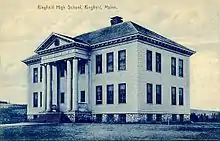
After adopting Estes Park as his summer home, Stanley turned more from his eastern business ventures and toward philanthropy and the management of his hotel. In 1903, the year he first went to Colorado to treat his tuberculosis, he endowed the construction of a new high school in his old hometown of Kingfield, Maine which remains standing today as a museum dedicated to Stanley's life. In 1905, the dry plate company was sold to Eastman Kodak and the Stanley brothers focused their attention on the Stanley Motor Carriage Company. By 1917, at the age of 68, Freelan and Francis were ready for retirement and stepped down from management. That year, Francis and his wife Augusta were able to visit his brother's property in Estes Park for the first time. The following year, Francis was killed tragically while driving a Stanley automobile on a country road near Wenham, Massachusetts. In 1918, F.O. Stanley sold his interests in the motor carriage company to his nephew-in-law, Prescott Warren who carried on with the production of steam-powered vehicles until the company's closure in 1926.
Stanley served on many boards and committees. He was a trustee of Hebron Academy from 1911 and president of the board from 1914 until his death. He endowed the school with funds to build, in 1926, Stanley Arena, the first enclosed high school hockey rink in the nation where future pro-hockey players Eddie Jeremiah (Boston Bruins) and Danny Sullivan (Hershey Bears) would play for Hebron as student athletes. From 1913, he was a trustee of the Maine State Sanatorium Association. In Estes Park, he served as president of numerous organizations working tirelessly to improve and develop the town.
In 1933, his own steam-powered car having long been out-competed by combustion-powered models, F.O. Stanley called upon Henry Ford, who now dominated the automobile industry, at his factory in Dearborn, Michigan. During the visit, Ford bought several Stanley violins.
By 1926, Flora Stanley's eyesight had deteriorated to such a point that she was no longer comfortable in places she didn't know well. Although the Stanleys continued to travel between Newton and Estes Park, Freelan began to think of retirement from public life, selling his hotel. In 1939, while in Estes Park, Flora suffered a stroke and died soon thereafter at their Colorado home, Rockside. The next year Stanley returned to Estes Park for the summer but maintained an inconspicuous presence. Shortly after his return to Newton in 1940, Stanley died on October 2 of heart failure.[1]
Personal characteristics
Raised in a Calvinist household in the tee-totaling State of Maine, Stanley did not drink alcoholic beverages. Nor did he smoke cigars, unlike many men of his day, having survived tuberculosis. He was discreet in his religious and political affiliations. Stanley wrote a letter to the Newton Graphic in 1902 criticizing Christian Science and expressing some negative opinions about orthodox interpretations of scripture. If Stanley held religious beliefs at all, it is likely that he was a modernist christian who shared the attitudes espoused by biblical scholar Charles Augustus Briggs in his controversial address to the Union Theological Seminary in 1876. Stanley's upbringing gave him a love of practical knowledge as well as an appreciation for music and poetry which he enjoyed throughout his life. His favorite pastimes were bowling, playing billiards and working in his violin shop. The results of a bowling tournament held at the Hunnewell Club, published in the Newton Graphic, show Stanley placed first and his twin brother in 8th place. He was fiscally conservative and insisted on paying and being paid in cash. He was devoted to his wife Flora to whom he was married for 63 years before her death. They never had children but they remained close to their nieces and nephews and were notoriously kind to the children of Estes Park and those who visited the Stanley Hotel. He was not without a sense of humor, posing for photographs dressed as "your western man" in a ten-gallon hat and woolly chaps, or as the "King of Estes Park" with a tin canister on his head for a crown, placed there by the local children.
Architectural designs
- 1894, F.O. Stanley House, 165 Hunnewell Avenue, Newton, MA
- 1897-1998, The Hunnewell Club, 84 Eldredge Street, Newton, MA
- 1900-1904, "Hillholm" (Amos G. Winter House), 33 Winter's Hill Road, Kingfield, ME
- 1903-1905, "Rockside" (F.O. Stanley House), 415 W Wonderview Avenue, Estes Park, CO (With Henry Rogers)
- 1907-1908, The Stanley Hotel, 333 E Wonderview Avenue, Estes Park, CO (with Henry Rogers & Theilman Robert Weiger)
Legacy
F.O. Stanley was inducted into the Colorado Business Hall of Fame by Junior Achievement - Rocky Mountain and the Denver Metro Chamber of Commerce in 2016.
In 2016, the Stanley Hotel announced a competition for a sculpture to be the centerpiece of the terrace in front of the hotel. Sculptors Sutton Betti and Daniel Glanz won the competition with a sculpture of F.O. Stanley holding one of his violins. The sculpture was installed and dedicated on September 29, 2016.
See also
People
Places
- Kingfield, ME
- Newton, MA
- Estes Park, CO
- National Register of Historic Places listings in Franklin County, Maine
- National Register of Historic Places listings in Larimer County, Colorado
- National Register of Historic Places listings in Newton, Massachusetts
Institutions
References
- "Freelan O. Stanley. He and His Twin Brother Were Makers of the Stanley Steamer". New York Times. October 3, 1940. Retrieved 2008-07-03.
Freelan O. Stanley, who with his twin brother, the late Francis Stanley, invented the Stanley Steamer, which appeared in the late Nineties in competition with the early gasoline driven motor cars, died tonight in his home at Newton. His age was 91. He had returned ten days ago from Colorado, where he spent the Summer.
- http://www.britannica.com/EBchecked/topic/640899/Western-State-Normal-School
- Doris A. Isaacson, ed. (1937). Maine: A Guide Down East. Federal Writers Project. pp. 381–386. ISBN 9781603540186.
Freeland [sic] O. Stanley, an inventor, was principal of the town's first high school, and early engines of the Stanley Steamer, one of the first automobiles,
- "Peacherina" was a favorite phrase of Eastman's, he having applied it in similar context to Maxfield Parrish's 1922 painting Interlude
- "Rocky Mountain National Park - Culture". US-Parks.com. Retrieved 2007-05-10.
